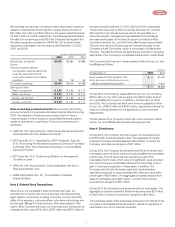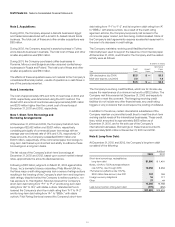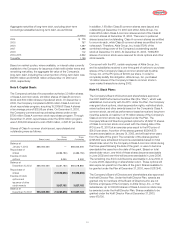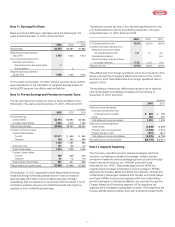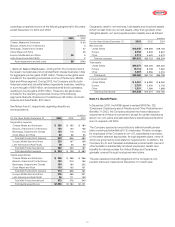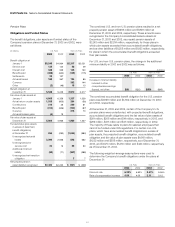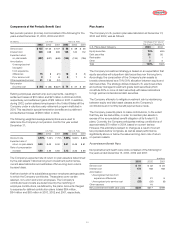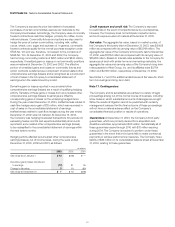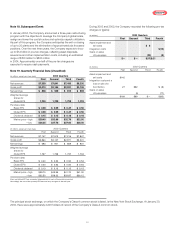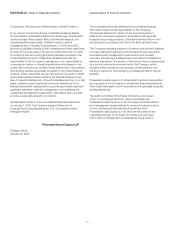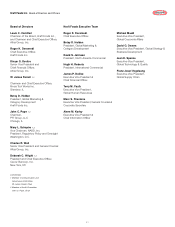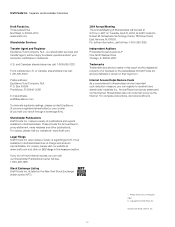Kraft 2003 Annual Report Download - page 59
Download and view the complete annual report
Please find page 59 of the 2003 Kraft annual report below. You can navigate through the pages in the report by either clicking on the pages listed below, or by using the keyword search tool below to find specific information within the annual report.
57
The Company’s postemployment plans are not funded. The
changes in the benefit obligations of the plans at December 31, 2003
and 2002, were as follows:
(in millions)
2003 2002
Accumulated benefit obligation at January 1 $295 $520
Service cost 10 19
Benefits paid (106) (141)
Actuarial (gains) losses 42 (103)
Accumulated benefit obligation at December 31 241 295
Unrecognized experience gains 56 112
Accrued postemployment costs $297 $407
The accumulated benefit obligation was determined using an
assumed ultimate annual turnover rate of 0.3% in 2003 and 2002,
assumed compensation cost increases of 4.0% in 2003 and 2002,
and assumed benefits as defined in the respective plans.
Postemployment costs arising from actions that offer employees
benefits in excess of those specified in the respective plans are
charged to expense when incurred.
Note 15. Additional Information:
(in millions)
For the Years Ended December 31, 2003 2002 2001
Research and development
expense $380 $360 $ 358
Advertising expense $1,176 $1,145 $1,190
Interest and other debt
expense, net:
Interest expense, Altria Group, Inc.
and affiliates $31 $243 $1,103
Interest expense, external debt 647 611 349
Interest income (13) (7) (15)
$665 $847 $1,437
Rent expense $452 $437 $ 372
Minimum rental commitments under non-cancelable operating
leases in effect at December 31, 2003, were as follows:
(in millions)
2004 $307
2005 227
2006 170
2007 134
2008 113
Thereafter 236
$1,187
Note 16. Financial Instruments:
Derivative financial instruments: The Company operates
globally, with manufacturing and sales facilities in various locations
around the world, and utilizes certain financial instruments to
manage its foreign currency and commodity exposures, which
primarily relate to forecasted transactions. Derivative financial
instruments are used by the Company, principally to reduce
exposures to market risks resulting from fluctuations in foreign
exchange rates and commodity prices by creating offsetting
exposures. The Company is not a party to leveraged derivatives
and, by policy, does not use financial instruments for speculative
purposes. Financial instruments qualifying for hedge accounting
must maintain a specified level of effectiveness between the hedging
instrument and the item being hedged, both at inception and
throughout the hedged period. The Company formally documents
the nature of and relationships between the hedging instruments
and hedged items, as well as its risk-management objectives,
strategies for undertaking the various hedge transactions and
method of assessing hedge effectiveness. Additionally, for hedges of
forecasted transactions, the significant characteristics and expected
terms of the forecasted transaction must be specifically identified,
and it must be probable that each forecasted transaction will occur.
If it was deemed probable that the forecasted transaction will not
occur, the gain or loss would be recognized in earnings currently.
The Company uses forward foreign exchange contracts and foreign
currency options to mitigate its exposure to changes in foreign
currency exchange rates from third-party and intercompany
forecasted transactions. Substantially all of the Company’s derivative
financial instruments are effective as hedges. The fair value of all
derivative financial instruments has been calculated based on
market quotes. The primary currencies to which the Company is
exposed, based on the size and location of its businesses, include
the euro, Swiss franc, British pound and Canadian dollar. At
December 31, 2003 and 2002, the Company had option and
forward foreign exchange contracts with aggregate notional
amounts of $2,486 million and $575 million, respectively, which
are comprised of contracts for the purchase and sale of foreign
currencies. The effective portion of unrealized gains and losses
associated with forward contracts is deferred as a component
of accumulated other comprehensive earnings (losses) until the
underlying hedged transactions are reported on the Company’s
consolidated statement of earnings.


